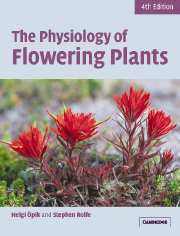Book contents
- Frontmatter
- Contents
- Preface
- Chapter 1 Introduction
- Part I Nutrition and transport
- Chapter 2 Flow of energy and carbon through the plant: photosynthesis and respiration
- Chapter 3 Water relations
- Chapter 4 Mineral nutrition
- Chapter 5 Translocation of organic compounds
- Part II Growth and development
- Appendix
- Index
- References
Chapter 2 - Flow of energy and carbon through the plant: photosynthesis and respiration
Published online by Cambridge University Press: 05 June 2012
- Frontmatter
- Contents
- Preface
- Chapter 1 Introduction
- Part I Nutrition and transport
- Chapter 2 Flow of energy and carbon through the plant: photosynthesis and respiration
- Chapter 3 Water relations
- Chapter 4 Mineral nutrition
- Chapter 5 Translocation of organic compounds
- Part II Growth and development
- Appendix
- Index
- References
Summary
Introduction
All living organisms need a supply of raw materials from which their bodies can be constructed, and a supply of energy. This energy is needed for growth, i.e. for the formation of their bodies, also for the maintenance of their bodies, and for all the various types of work, chemical and mechanical, that are carried out by living systems.
Life as we know it is based on organic compounds of carbon (C). This element accordingly occupies a central place among the raw materials and it is found on earth abundantly in its inorganic forms as carbon dioxide (CO2), carbonate (CO32 −) and bicarbonate (HCO3−). The ultimate energy source for most life forms on earth is the thermonuclear energy of the sun, transmitted to earth as electromagnetic radiation, light. Photosynthesis is the process by which the solar light energy is transformed into the chemical bond energy of organic carbon compounds. Photosynthesis is thus simultaneously a process of energy transduction, and a process by which inorganic carbon is converted to organic form and incorporated into living organisms. Chemically it is a reductive process. Respiration is the process of oxidative breakdown by which the energy stored in the organic products of photosynthesis is tapped for driving metabolism, for growth, for movements, and by which the C is returned to inorganic form again as CO2.
- Type
- Chapter
- Information
- The Physiology of Flowering Plants , pp. 9 - 59Publisher: Cambridge University PressPrint publication year: 2005



